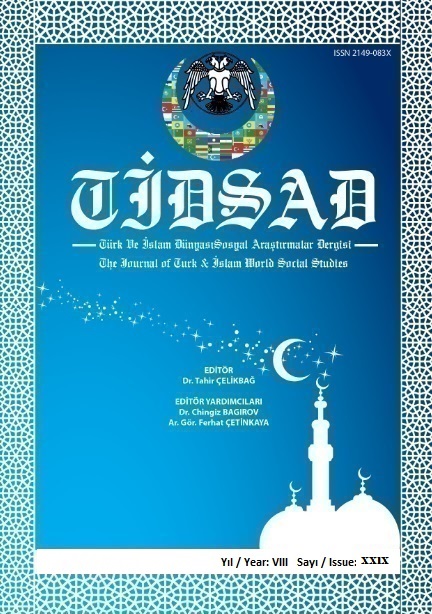J. F. MAZAS OP.36 “ETUDES SPECİALES” METODUNA İLİŞKİN ÖRNEK ANALİZ YÖNTEMİ (27 NUMARALI ETÜT ÖRNEĞİ)
Author :
Abstract
Bu araştırma; mesleki müzik eğitimi veren kurumlarda viyola eğitimi için sıklıkla kullanılan J. F. Mazas’ın op.36 “Etudes Speciales” adlı metodun armonik, form ve teknik yönden örnek bir analiz yaklaşımını amaçlayan bir çalışma olup; 27 numaralı etüdün incelenmesi ile sınırlıdır. Durum tespitine dayalı betimsel bir araştırma olan çalışmada; eserin 115 ölçüden oluştuğu, re minör tonda, andante hızında ve 4/4’lük olduğu, sağ el teknikleri bakımından legato, détaché (detaşe), bağlı staccato (stakato), portato, çift ses, pizzicato, arco, aksan, crescendo, decrescendo, gibi teknikleri kapsadığı, sol el teknikleri bakımından ise I-II-III-V geçişli pozisyonların kullanıldığı, çift ses, trill, çarpma, süsleme, flageolet (flajöle), mordan gibi süsleme ve diğer bazı teknikleri kapsadığı anlaşılmıştır. Etüt form açısından ABA formunda, üç bölümlü şarkı biçiminde yazılmış, armonik olarak ise re minör tonunda giriş yaparak fa majör tonunda varış köprüsü şeklinde ilerleyip sib majör tonunda olan B bölümüne başlangıç yapmıştır. B bölümünden tekrar A bölümüne hazırlık amacıyla 14 ölçülük bir dönüş köprüsünün la majörde kalıp tekrar re minör tonunda A bölümü başlamış ardından 11 ölçülük bir codetta ile eser sonlanmıştır. Yapılan çalışmanın diğer metotlarda yer alan etüt analizlerine de ışık tutacağı düşünülmektedir.
Keywords
Abstract
This study aims an example analysis approach of the method titled J. F. Mazas' op.36 "Etudes Speciales" which is frequently used for viola training in institutions providing professional music education in terms of its harmonic, form and technical aspects, and it is limited with the examination of the etude no. 27. In the study which is a descriptive one based on assessment, it was understood that the work consists of 115 meters, is in D minor, andante tempo and 4/4, covers techniques such as legato, détaché, connected staccato, portato, double voice, pizzicato, arco, accent, crescendo, decrescendo for right hand techniques and, for left hand techniques, I-II-III-V transition positions are used along with double voice, trill, grace note, ornament, flageolet, ornaments such as mordent and some other techniques. In terms of form, the etude is in ABA form, composed as a song of three sections, and in terms of harmonic, it starts with D minor and progresses with an arrival bridge in F major and then B section in B-flat major starts. A 14-meter return bridge continued in A major as preparation to A section after B section, then A section starts in D minor and the work ends with 11-meter codetta. It is considered that the study will shed light on the etude analyzes in other methods.
Keywords
- Albuz, A. (1995). Başlangıç viyola öğretim ve tekniklerinin incelenmesi sınanması ve değerlendirilmesi. Gazi Üniversitesi Fen Bilimleri Enstitüsü, Ankara.
- Alpay, A. (2010). Viyola öğretiminde kullanılan Mazas “Etudes Brillantes Op.36 Book II” metodunun sağ el ve sol el teknikleri yönünden incelenmesi. Yüksek Lisans Tezi, Gazi Üniversitesi, Eğitim Bilimleri Enstitüsü, Güzel Sanatlar Eğitimi Ana Bilim Dalı, Müzik Öğretmenliği Bilim Dalı, Ankara.
- Büyüköztürk, Ş., Kılıç Çakmak, E., Akgün, Ö. E., Karadeniz, Ş., Demirel, F. (2016). Bilimsel araştırma yöntemleri. Pegem Akademi: Ankara
- Çetinkaya, İ. (2011). Güzel sanatlar ve spor liseleri müzik bölümlerinde uygulanan viyola dersi öğretim programında yer alan 9. Sınıf düzeyindeki devinişsel kazanımlara, öğrenci ve öğretmen görüşlerine göre ulaşılma durumları. Yüksek lisans tezi, Gazi Üniversitesi Eğitim Bilimleri Enstitüsü Güzel Sanatlar Eğitimi Anabilim Dalı Müzik Öğretmenliği Bilim Dalı, Ankara.
- Jacques-Fereol Mazas (2020). https://en.wikipedia.org/wiki/Jacques_F%C3%A9r%C3%A9ol_Mazas adresinden erişilmiştir.
- Karan, M. (2011). Özengen müzik eğitimi veren kurumlarda çalgı eğitimi alan öğrencilerin mesleki yönelimlerinin incelenmesi. Yüksek lisans tezi, Gazi Üniversitesi, Eğitim Bilimleri Enstitüsü, Ankara.
- Koçak, A, Arun, Ö. (2013). İçerik analizi çalışmalarında örneklem sorunu. Selçuk İletişim, 4(3), 21-28.
- Özdemir, G, Dalkıran, E. (2013). Viyola öğretimine yönelik örnek etüt analizi. İnönü Üniversitesi Sanat ve Tasarım Dergisi, 1(2).
- Özkan, E, Orhan, Ş. (2017). Sebastian Lee Op.113 etüt kitabı I. etüdün teknik ve biçimsel analizi. Fine Arts, 12(2), 83-91.
- Öztürk, F. G., Özay, S., (2008). Keman ve viyola eğitiminde kullanılan Mazas “Special Etudes Op.36” metodunun sağ ve sol el teknikleri yönünden incelenmesi, Gazi Üniversitesi, Gazi Eğitim Fakültesi Dergisi, 28(3), 57-74.
- Serin, Özparlak, Ç. ve Kalkanoğlu, B. (2018). Piyano eğitiminde dört el çalışmalarının yeri ve önemi. The Journal of Academic Social Science, 6(68), 610-617.
- Sonsel, Ö.B. (2017). Bireysel çalgı viyola dersinin öğretim elemanları görüşleri açısından değerlendirilmesi. EJournal of New World Sciences Academy, 12(2), 125-134.
- Sonsel, Ö. B. (2019). Hoffmeister "Etuden Fur Viola" Metodu'nun İncelenmesi. Turkish Studies Educational Sciences, 14(1), 149,165.
- Sonsel, Ö. B. (2020). Ayfer Tanrıverdi-Viyola Metodu 1 ve Ömer Can- Viyola Eğitimi 1 kitaplarının karşılaştırmalı incelemesi. H. Şahin (Ed)., Eğitim Bilimleri Teori, Güncel Araştırmalar ve Yeni Eğilimler içinde (s. 87-99). Karadağ:Çetinje
- Şen, S., S. (1992). Evrensel keman teknikleri kullanılarak Türk folkloruna ve evrensel müziğe dayalı özgün keman etütlerinin yaratılması. Yüksek lisans tezi. Marmara Üniversitesi, Fen Bilimleri Enstitüsü.
- Tepeli, H. (2018). Ankara’daki özengen müzik eğitimi veren kurumların çok yönlü incelenmesi. Yüksek lisans tezi, Necmettin Erbakan üniversitesi, Eğitim Bilimleri Enstitüsü, Güzel Sanatlar Eğitimi Anabilim dalı, Müzik Eğitimi Bilim Dalı, Konya.
- Uçan, A. (2005). Müzik eğitimi temel kavramlar ilkeler yaklaşımlar ve Türkiye’deki durum. Genişletilmiş 3. Baskı, Evrensel Yayınevi: Ankara.
- Varış, Y. A. (2002). Viyola ve kemanın benzer ve farklı özelliklerinin fiziki ve teknik kullanım açısından incelenmesi ve bu özelliklerin ortaya çıkardığı ilişkilerin viyola eğitimine yansıması. Yüksek Lisans Tezi, Abant İzzet Baysal Üniversitesi Sosyal Bilimler Enstitüsü, Bolu.





